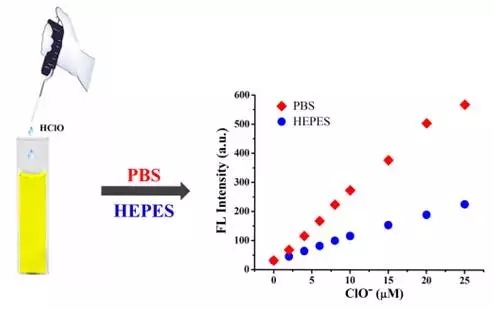Prof. Sun Shiguo from Northwest A&F University and Prof. Wang Wei and Prof. Chen Jianxin from Beijing University of Chinese Medicine published an article in Chem. Commun. They found that HEPES buffer system is not suitable for fluorescence detection of hypochlorous acid because HEPES can be oxidized by hypochlorous acid. A novel hypochlorous acid fluorescent probe was designed based on the specific oxidation reaction between hypochlorous acid and azo group. The probe has good water solubility and can be selectively and highly sensitive in pure PBS buffer system.

In addition to HEPES, the reducing buffer solution, such as Tris, is also not suitable for the fluorescence detection of hypochlorous acid, which provides a basis for the selection of buffer solutions during other detection of reactive oxygen species.
So what’s the characteristics of HEPES (CAS 7365-45-9)? What experiments is HEPES suitable for? Let us summarize together:
HEPES buffers, even all Good's buffers, have the following characteristics:
(1) High solubility in water;
(2) Membrane impermeability and not easy to penetrate biofilm;
(3) Limited impact on biochemical reactions, chemical and enzymatic hydrolysis, and no complex or precipitation with metal ions;
(5) Ion concentration, solution composition and temperature have little effect on dissociation;
The application of HEPES application:
HEPES is widely used in a variety of biochemical reactions and as a buffering agent in certain cell culture media. The final concentration is 10~50mmol/L, and the general culture solution contains 20mmol/L to achieve the buffering capacity. In addition, due to its lack of cytotoxicity, HEPES buffers are commonly used in the research of organelles and highly variable pH-sensitive proteins and enzymes, as well as biochemical diagnostic kits, DNA/RNA extraction kits and PCR diagnostic kits.
However, it should be noted that in addition to the above mentioned experiments, HEPES has some interference with the reaction between DNA and restriction enzymes, and it is not suitable for the determination of protein content by Lowry's method.
The choice of buffer in biochemical experiments is very important and will directly affect the results of the experiment. Have you chosen the most suitable buffer for your experiment?
References
HEPES is not suitable for fluorescence detection of HClO: a novel probe for HClO in absolute PBS. Chem. Commun., 2016, 52, 5064-5066, DOI: 10.1039/C6CC00880A
Copyright © Suzhou Yacoo Science Co., Ltd. All Rights Reserved
Friendly Links :
online service